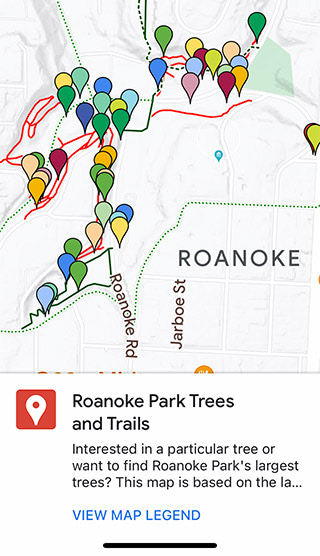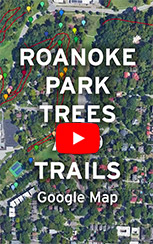 Click for the Roanoke Park Trees and Trails Google MapExplore Roanoke Park’s trails and help find the biggest trees in the park!
Click for the Roanoke Park Trees and Trails Google MapExplore Roanoke Park’s trails and help find the biggest trees in the park!
Roanoke Park's volunteer naturalist Chris DeLong has combined data from the 2012 tree inventory with lots of on-the-ground scouting to produce a custom Google Map you can use to explore the park. The trail paths on this map are more accurate and complete than can be found anywhere else. Markers for the park’s largest trees and others have been added to the map with each containing ID and info in a popup. Links to Missouri Botanical Garden pages are included (but are only clickable on desktop browsers).
Enjoy the trails and go find those trees!
Roanoke Park Trees and Trails
https://maps.app.goo.gl/h3p9QqMunanr4CVq5?g_st=ic
You can help improve this map by finding the trees and emailing Chris at This email address is being protected from spambots. You need JavaScript enabled to view it. with discrepancies. Some of the 2012 champions may have fallen down, or were misidentified initially. While the 2012 Tree Inventory was a snapshot in time, we’ll try to continually update this map with your help.
 Click for a video explaining Roanoke Park Trees and TrailsEven in just the process of rolling out this map several corrections and discoveries have been made. The 2012 second place chinkapin oak is now the park champion, after the former champ apparently got hit by lightning. Yikes! (It looks like it is trying to survive, despite dead stripes down two sides.) The old champ is west of Karnes, and the new champ is by the paw paw patch above the brick road, right above the lower trail. Also it looks like we have a kind of Hickory tree we didn't know about. The champion "hickory" in 2012 appears to be a Shellbark Hickory, Carya laciniosa. That species is also called Kingnut, for having the largest of all hickory nuts. We'll try to beat the critters to some to help confirm the identification.
Click for a video explaining Roanoke Park Trees and TrailsEven in just the process of rolling out this map several corrections and discoveries have been made. The 2012 second place chinkapin oak is now the park champion, after the former champ apparently got hit by lightning. Yikes! (It looks like it is trying to survive, despite dead stripes down two sides.) The old champ is west of Karnes, and the new champ is by the paw paw patch above the brick road, right above the lower trail. Also it looks like we have a kind of Hickory tree we didn't know about. The champion "hickory" in 2012 appears to be a Shellbark Hickory, Carya laciniosa. That species is also called Kingnut, for having the largest of all hickory nuts. We'll try to beat the critters to some to help confirm the identification.
You could also add tree observations to iNaturalist if good ID pictures can be taken, adding to our Roanoke Park Biodiversity Project: inaturalist.org/projects/roanoke-park-biodiversity What are good ID pictures? More than one, clear and hopefully focussing on distinguising characteristics: the "key things" that separate a tree species from close relatives. If you don't know and are learning, take a variety! iNaturalist lets you upload four photos initially, but then you can keep hitting the + icon and adding more. Bark, leaves, flowers, fruit or seeds, twigs, winter buds - all can show useful ID characters.